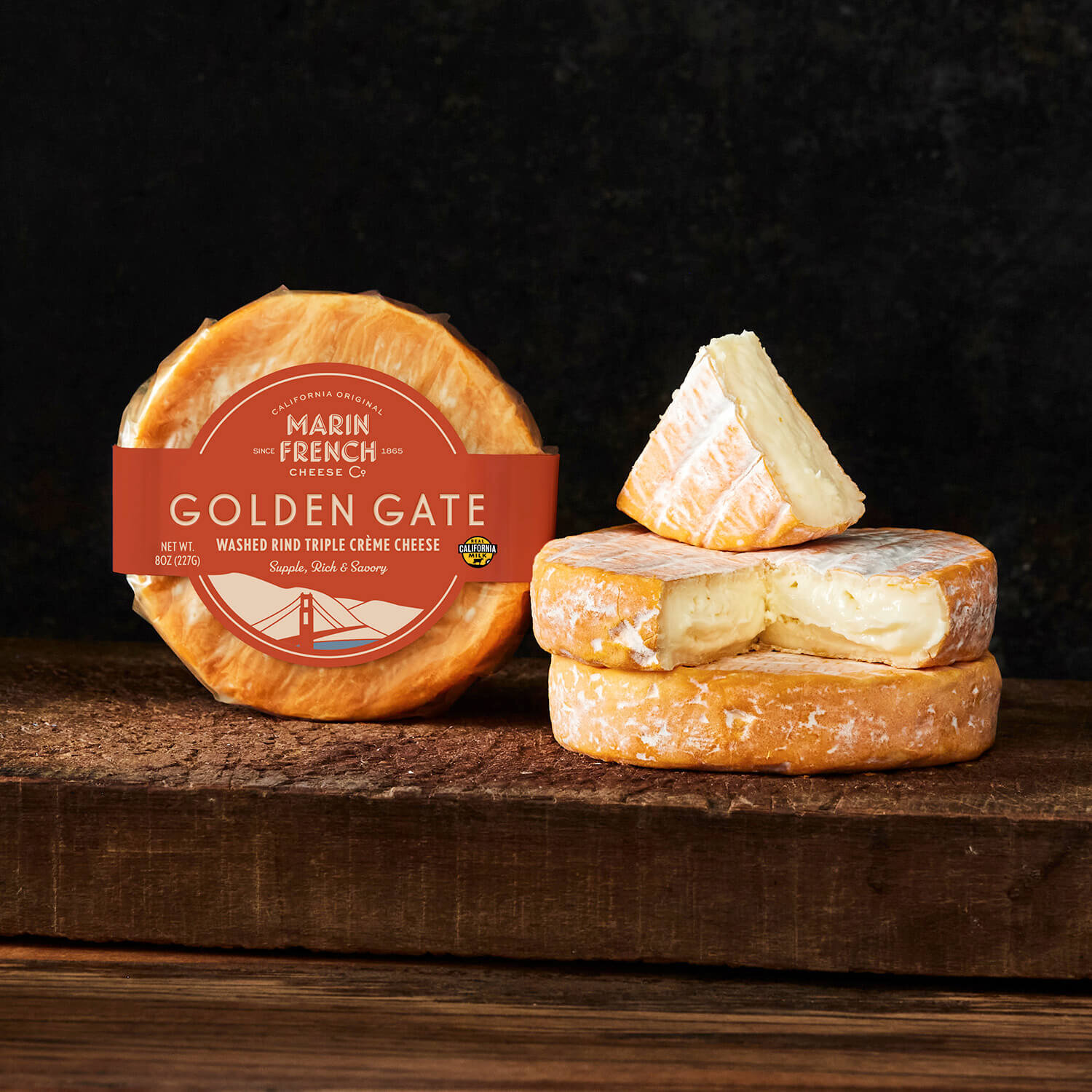Orange You Glad You Discovered the Washed Rind Cheeses of Northern California?
The bucolic coastal and agricultural counties just north of San Francisco have long been an epicenter of artisanal cheese in America. In fact, I grew up in the suburbs of San Francisco, less than 25 miles away from the oldest cheese company in the US. Located in Petaluma on the property with a large pond, Rouge et Noir was a favorite spot for factory visits and picnics. After several changes in ownership and rebranding, the creamery is now Marin French Cheese and is known for making very traditional European style cheeses including triple creme cheeses, camembert and brie and an Austrian inspired cheese called Schloss with a distinctive orange rind.
Schloss
Schloss photo courtesy Marin French Cheese
Schloss was a washed rind triple crème cheese that Marin French first made in 1901. Made from pasteurized cow’s milk and cream, it was aged for 2 weeks and repeatedly washed in brine. The pale orange rind cheese won a silver medal in the World Cheese Awards in 2014. Recently Schloss was discontinued to make way for a new washed rind cheese, Golden Gate.
Golden Gate
Golden Gate has a stronger color and flavor due to more washing and an even greater presence of the natural Brevibacterium linens bacterium from the coastal air at Marin French Cheese Co.'s creamery. Golden Gate undergoes 4 rounds of handwashing in its 2-week aging process. While the stunning color makes it a dramatic addition to cheese plates, its classic washed rind aroma and flavors are the real reason to seek it out.
Red Hawk
Red Hawk photo credit Sarah Remington
One of the most famous orange-washed rind cheeses is from Point Reyes Station, about 20 miles closer to the coast. Red Hawk is an organic cheese made by Cowgirl Creamery. It is part of American cheese lore that Red Hawk was created “by accident.” Made from the triple cream recipe for the creamery’s Mt. Tam, B. linens in the cheesemaking facility took hold and as the cheese was washed with brine the B.linens increased and the resulting cheese is one of the most famous American artisanal cheeses. It is aged 6 weeks and was awarded "Best in Show" at the American Cheese Society in 2003 and won a Gold Ribbon in 2009.
Comparing Golden Gate and Red Hawk
The rind of Golden Gate is so incredibly bright orange it’s hard to believe that it’s all-natural. The wheel is shorter and firmer than Red Hawk. The cheeses share some of the same bacon, caramelized onion and yeasty flavors but Golden Gate is much saltier and has a pleasantly funky seafood flavor and aroma of steamed clams. In tasting them side by side, Red Hawk has more complexity and subtle sweetness, whereas Golden Gate is more pungent. But the texture and flavor change with time, from firm to gooey and from mild to pungent.
Nicasio Square
Nicasio Square photo courtesy Nicasio Cheese Company
There is another noteworthy and award-winning semi-soft, washed-rind cheese made with organic farmstead cow’s milk and B. linens from the North Bay. Nicasio Valley Cheese Company makes an orange rind Taleggio inspired cheese, the Nicasio Square. Named for the town square, it is square-shaped just like Taleggio. It’s is aged for about a month. It’s also a prize winner, including being chosen a top 5 finisher in class at the World Cheese Championship.
Washed Rind Cheeses
Washed rind cheeses can be hard or soft, and the rind can often have a texture that can be crunchy thanks to Ikaite calcium carbonate crystal, and Struvite, a magnesium ammonium phosphate crystal. Cheese science expert Pat Polowsky of the Cheese Science Toolkit explained that the mineral components are omnipresent in cheese and that the carbonate and ammonium are derived from the gases created by the surface microbes.
Washed rind cheeses bark is greater than their bite. While their aroma can be pungent their flavor is typically described as savory or umami with flavors that include bacon, mushrooms, garlic, caramelized onion, yeast, nuts, butter and sometimes even fruit. The flavor of the cheese comes in part from the repeated washing with a salt solution, or even brandy, beer or wine. Two of the most famous examples of washed-rind cheeses are the Italian Taleggio, which was said to be produced in Roman times and Epoisses which was created by monks in France in the 1600s. And if you’re wondering if you can eat the rind, you can. Learn in our Definitive Guide to 5 Kinds of Cheese Rinds and Which Are Edible.
Cheeses reflect terroir, and washed rind cheeses with local B. linens bacterium are a Northern California classic, well worth exploring and enjoying.




